Exploring Environmental Policy: Wicked Problems and Science Policy Gap
VerifiedAdded on 2023/04/25
|9
|1893
|271
Essay
AI Summary
This essay delves into the complexities of environmental policy, focusing on 'wicked problems'—challenges that defy easy solutions due to their intricate socio-economic and environmental dimensions, exemplified by the Murray Darling Basin management. It underscores the importance of understanding the historical context of policy problems, identifying stakeholders, and adopting evidence-based approaches, referencing Australia's climate change policies as a case study. The essay further examines the 'science-policy gap,' highlighting the disconnect between scientific findings and policy implementation, and emphasizes the need for better integration of scientific knowledge into policy-making. It concludes by discussing strategies for making sound policy decisions in the face of scientific uncertainty, using the WA State Planning Policy 2.6 as an example, and stresses the role of policy briefs in ensuring clear and effective policy implementation. Desklib offers this solution and many more to aid students in their studies.
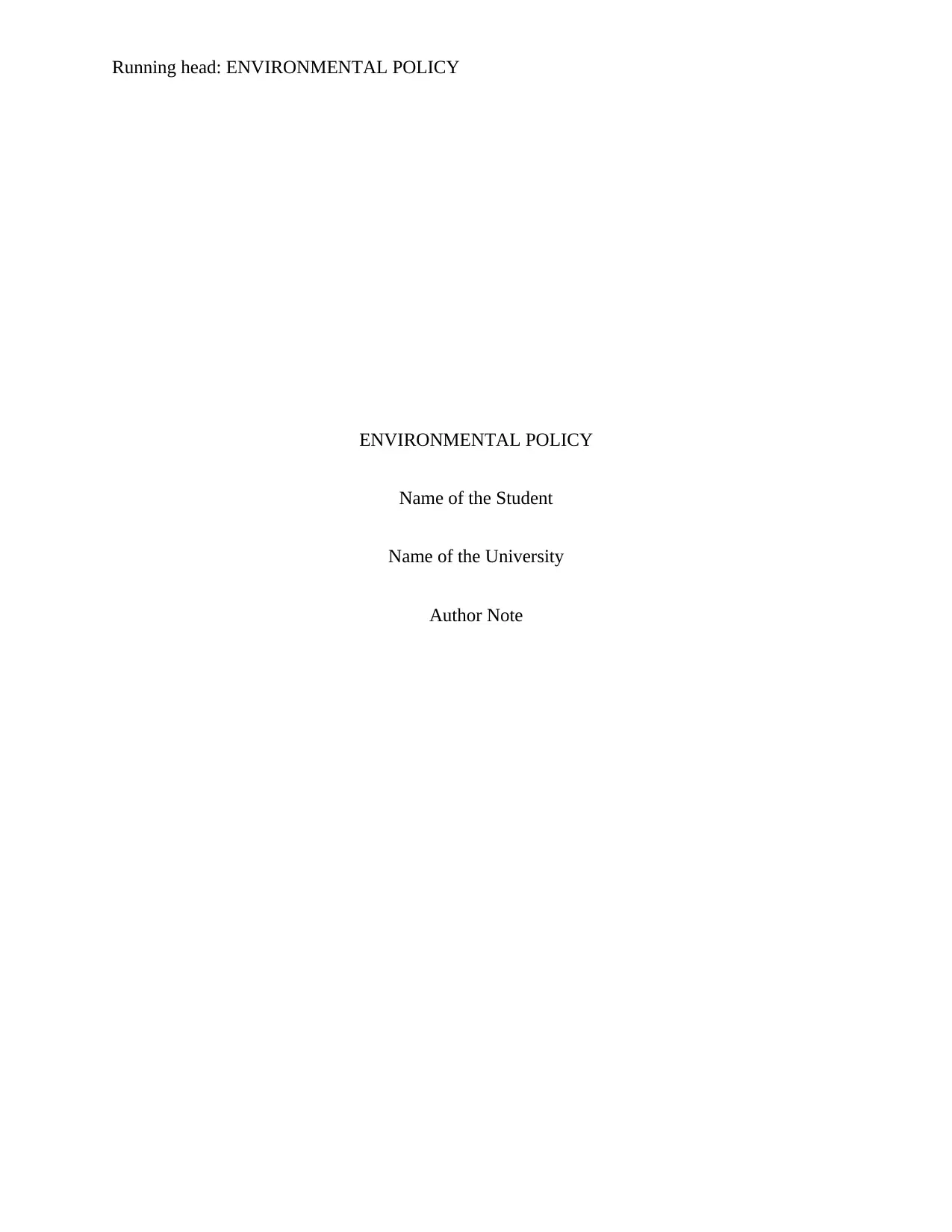
Running head: ENVIRONMENTAL POLICY
ENVIRONMENTAL POLICY
Name of the Student
Name of the University
Author Note
ENVIRONMENTAL POLICY
Name of the Student
Name of the University
Author Note
Paraphrase This Document
Need a fresh take? Get an instant paraphrase of this document with our AI Paraphraser

2
ENVIRONMENTAL POLICY
TOPIC 3: Wicked environmental policy problems
A wicked policy problem is an issue that is difficult to manage either due to the changing nature
of its requirement or because of the complexity of the issue that prevents a proper solution or a
guideline that can be attributed to the problem. The conventional and scientific way of
rationalizing cannot be always used to address a social concern that is characterized with the
complex social attributes. The problems or issues which create conflict while resolving a proper
guideline for the issue and is referred to as wicked policy problems. The term is thus used to
define the wicked nature of the issue that remains unsolved through implementation of any
policy or any given framework.
The characters of a wicked problem involve certain characters that prevent the issue or
problem from being solved through a policy framework or systematic regulation. The wicked
problem mostly involves a complex socio- economic system where there are a number of
interactions among the various elements of the system and are involved in such a manner that
framing a single policy or guideline becomes difficult. Catering to the interest of the all the
stakeholders within a systematic policy becomes difficult and therefore creates a unsolvable
problem that is ‘wicked’ in nature (Brooks et al 2006).
Case example: Management of the Murray Darling Basin.
The Murray Darling Basin or the MDB is one of the complex basin systems due to its interaction
with the social and physical characters. The basin has a rich supply of resources that allow the
region to flourish. However this interaction has led to the development of certain socio economic
and environmental issues that has depleted the resources and left an impact giving rise to
complex issues that have the nature of wicked problems (Williams 2017). The several
ENVIRONMENTAL POLICY
TOPIC 3: Wicked environmental policy problems
A wicked policy problem is an issue that is difficult to manage either due to the changing nature
of its requirement or because of the complexity of the issue that prevents a proper solution or a
guideline that can be attributed to the problem. The conventional and scientific way of
rationalizing cannot be always used to address a social concern that is characterized with the
complex social attributes. The problems or issues which create conflict while resolving a proper
guideline for the issue and is referred to as wicked policy problems. The term is thus used to
define the wicked nature of the issue that remains unsolved through implementation of any
policy or any given framework.
The characters of a wicked problem involve certain characters that prevent the issue or
problem from being solved through a policy framework or systematic regulation. The wicked
problem mostly involves a complex socio- economic system where there are a number of
interactions among the various elements of the system and are involved in such a manner that
framing a single policy or guideline becomes difficult. Catering to the interest of the all the
stakeholders within a systematic policy becomes difficult and therefore creates a unsolvable
problem that is ‘wicked’ in nature (Brooks et al 2006).
Case example: Management of the Murray Darling Basin.
The Murray Darling Basin or the MDB is one of the complex basin systems due to its interaction
with the social and physical characters. The basin has a rich supply of resources that allow the
region to flourish. However this interaction has led to the development of certain socio economic
and environmental issues that has depleted the resources and left an impact giving rise to
complex issues that have the nature of wicked problems (Williams 2017). The several
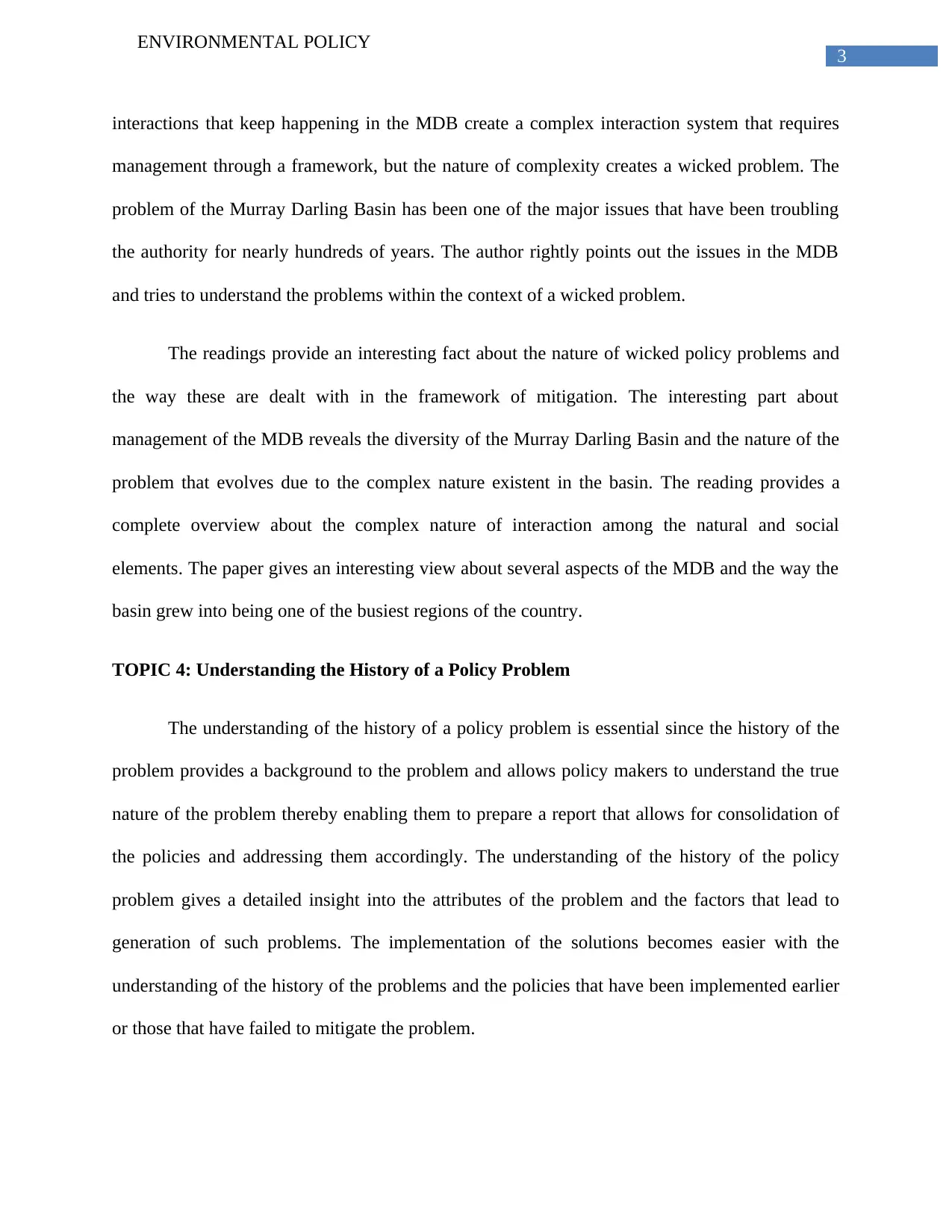
3
ENVIRONMENTAL POLICY
interactions that keep happening in the MDB create a complex interaction system that requires
management through a framework, but the nature of complexity creates a wicked problem. The
problem of the Murray Darling Basin has been one of the major issues that have been troubling
the authority for nearly hundreds of years. The author rightly points out the issues in the MDB
and tries to understand the problems within the context of a wicked problem.
The readings provide an interesting fact about the nature of wicked policy problems and
the way these are dealt with in the framework of mitigation. The interesting part about
management of the MDB reveals the diversity of the Murray Darling Basin and the nature of the
problem that evolves due to the complex nature existent in the basin. The reading provides a
complete overview about the complex nature of interaction among the natural and social
elements. The paper gives an interesting view about several aspects of the MDB and the way the
basin grew into being one of the busiest regions of the country.
TOPIC 4: Understanding the History of a Policy Problem
The understanding of the history of a policy problem is essential since the history of the
problem provides a background to the problem and allows policy makers to understand the true
nature of the problem thereby enabling them to prepare a report that allows for consolidation of
the policies and addressing them accordingly. The understanding of the history of the policy
problem gives a detailed insight into the attributes of the problem and the factors that lead to
generation of such problems. The implementation of the solutions becomes easier with the
understanding of the history of the problems and the policies that have been implemented earlier
or those that have failed to mitigate the problem.
ENVIRONMENTAL POLICY
interactions that keep happening in the MDB create a complex interaction system that requires
management through a framework, but the nature of complexity creates a wicked problem. The
problem of the Murray Darling Basin has been one of the major issues that have been troubling
the authority for nearly hundreds of years. The author rightly points out the issues in the MDB
and tries to understand the problems within the context of a wicked problem.
The readings provide an interesting fact about the nature of wicked policy problems and
the way these are dealt with in the framework of mitigation. The interesting part about
management of the MDB reveals the diversity of the Murray Darling Basin and the nature of the
problem that evolves due to the complex nature existent in the basin. The reading provides a
complete overview about the complex nature of interaction among the natural and social
elements. The paper gives an interesting view about several aspects of the MDB and the way the
basin grew into being one of the busiest regions of the country.
TOPIC 4: Understanding the History of a Policy Problem
The understanding of the history of a policy problem is essential since the history of the
problem provides a background to the problem and allows policy makers to understand the true
nature of the problem thereby enabling them to prepare a report that allows for consolidation of
the policies and addressing them accordingly. The understanding of the history of the policy
problem gives a detailed insight into the attributes of the problem and the factors that lead to
generation of such problems. The implementation of the solutions becomes easier with the
understanding of the history of the problems and the policies that have been implemented earlier
or those that have failed to mitigate the problem.
⊘ This is a preview!⊘
Do you want full access?
Subscribe today to unlock all pages.

Trusted by 1+ million students worldwide
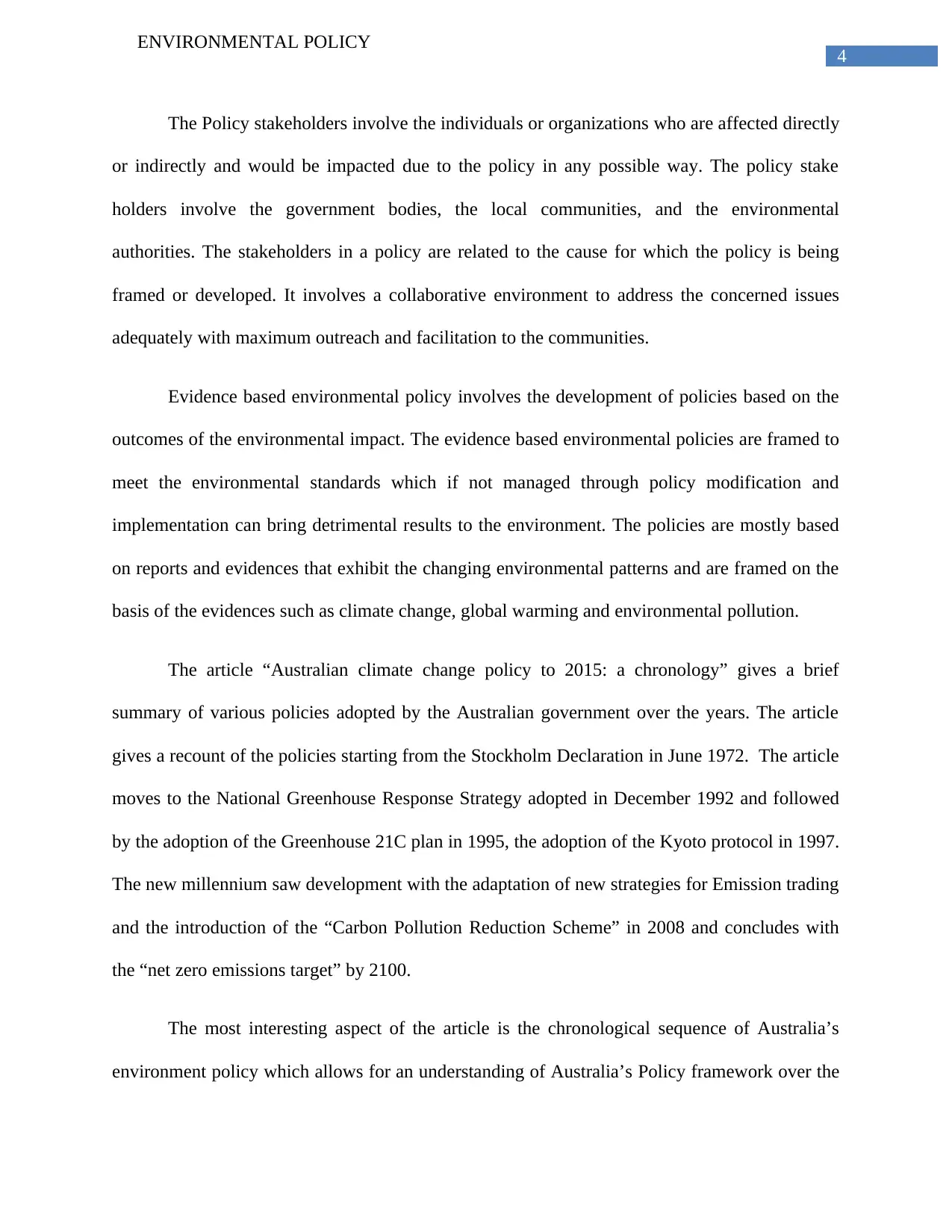
4
ENVIRONMENTAL POLICY
The Policy stakeholders involve the individuals or organizations who are affected directly
or indirectly and would be impacted due to the policy in any possible way. The policy stake
holders involve the government bodies, the local communities, and the environmental
authorities. The stakeholders in a policy are related to the cause for which the policy is being
framed or developed. It involves a collaborative environment to address the concerned issues
adequately with maximum outreach and facilitation to the communities.
Evidence based environmental policy involves the development of policies based on the
outcomes of the environmental impact. The evidence based environmental policies are framed to
meet the environmental standards which if not managed through policy modification and
implementation can bring detrimental results to the environment. The policies are mostly based
on reports and evidences that exhibit the changing environmental patterns and are framed on the
basis of the evidences such as climate change, global warming and environmental pollution.
The article “Australian climate change policy to 2015: a chronology” gives a brief
summary of various policies adopted by the Australian government over the years. The article
gives a recount of the policies starting from the Stockholm Declaration in June 1972. The article
moves to the National Greenhouse Response Strategy adopted in December 1992 and followed
by the adoption of the Greenhouse 21C plan in 1995, the adoption of the Kyoto protocol in 1997.
The new millennium saw development with the adaptation of new strategies for Emission trading
and the introduction of the “Carbon Pollution Reduction Scheme” in 2008 and concludes with
the “net zero emissions target” by 2100.
The most interesting aspect of the article is the chronological sequence of Australia’s
environment policy which allows for an understanding of Australia’s Policy framework over the
ENVIRONMENTAL POLICY
The Policy stakeholders involve the individuals or organizations who are affected directly
or indirectly and would be impacted due to the policy in any possible way. The policy stake
holders involve the government bodies, the local communities, and the environmental
authorities. The stakeholders in a policy are related to the cause for which the policy is being
framed or developed. It involves a collaborative environment to address the concerned issues
adequately with maximum outreach and facilitation to the communities.
Evidence based environmental policy involves the development of policies based on the
outcomes of the environmental impact. The evidence based environmental policies are framed to
meet the environmental standards which if not managed through policy modification and
implementation can bring detrimental results to the environment. The policies are mostly based
on reports and evidences that exhibit the changing environmental patterns and are framed on the
basis of the evidences such as climate change, global warming and environmental pollution.
The article “Australian climate change policy to 2015: a chronology” gives a brief
summary of various policies adopted by the Australian government over the years. The article
gives a recount of the policies starting from the Stockholm Declaration in June 1972. The article
moves to the National Greenhouse Response Strategy adopted in December 1992 and followed
by the adoption of the Greenhouse 21C plan in 1995, the adoption of the Kyoto protocol in 1997.
The new millennium saw development with the adaptation of new strategies for Emission trading
and the introduction of the “Carbon Pollution Reduction Scheme” in 2008 and concludes with
the “net zero emissions target” by 2100.
The most interesting aspect of the article is the chronological sequence of Australia’s
environment policy which allows for an understanding of Australia’s Policy framework over the
Paraphrase This Document
Need a fresh take? Get an instant paraphrase of this document with our AI Paraphraser
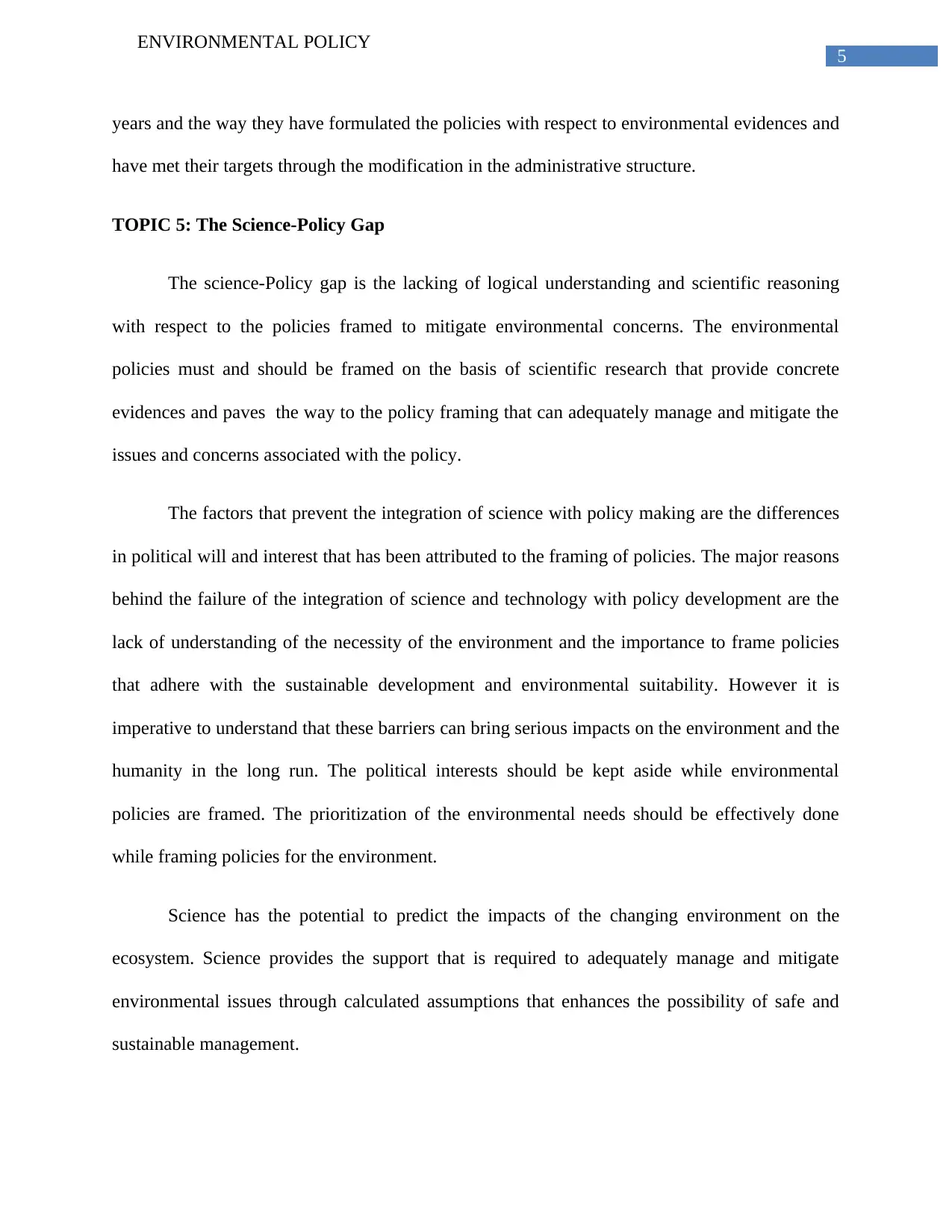
5
ENVIRONMENTAL POLICY
years and the way they have formulated the policies with respect to environmental evidences and
have met their targets through the modification in the administrative structure.
TOPIC 5: The Science-Policy Gap
The science-Policy gap is the lacking of logical understanding and scientific reasoning
with respect to the policies framed to mitigate environmental concerns. The environmental
policies must and should be framed on the basis of scientific research that provide concrete
evidences and paves the way to the policy framing that can adequately manage and mitigate the
issues and concerns associated with the policy.
The factors that prevent the integration of science with policy making are the differences
in political will and interest that has been attributed to the framing of policies. The major reasons
behind the failure of the integration of science and technology with policy development are the
lack of understanding of the necessity of the environment and the importance to frame policies
that adhere with the sustainable development and environmental suitability. However it is
imperative to understand that these barriers can bring serious impacts on the environment and the
humanity in the long run. The political interests should be kept aside while environmental
policies are framed. The prioritization of the environmental needs should be effectively done
while framing policies for the environment.
Science has the potential to predict the impacts of the changing environment on the
ecosystem. Science provides the support that is required to adequately manage and mitigate
environmental issues through calculated assumptions that enhances the possibility of safe and
sustainable management.
ENVIRONMENTAL POLICY
years and the way they have formulated the policies with respect to environmental evidences and
have met their targets through the modification in the administrative structure.
TOPIC 5: The Science-Policy Gap
The science-Policy gap is the lacking of logical understanding and scientific reasoning
with respect to the policies framed to mitigate environmental concerns. The environmental
policies must and should be framed on the basis of scientific research that provide concrete
evidences and paves the way to the policy framing that can adequately manage and mitigate the
issues and concerns associated with the policy.
The factors that prevent the integration of science with policy making are the differences
in political will and interest that has been attributed to the framing of policies. The major reasons
behind the failure of the integration of science and technology with policy development are the
lack of understanding of the necessity of the environment and the importance to frame policies
that adhere with the sustainable development and environmental suitability. However it is
imperative to understand that these barriers can bring serious impacts on the environment and the
humanity in the long run. The political interests should be kept aside while environmental
policies are framed. The prioritization of the environmental needs should be effectively done
while framing policies for the environment.
Science has the potential to predict the impacts of the changing environment on the
ecosystem. Science provides the support that is required to adequately manage and mitigate
environmental issues through calculated assumptions that enhances the possibility of safe and
sustainable management.
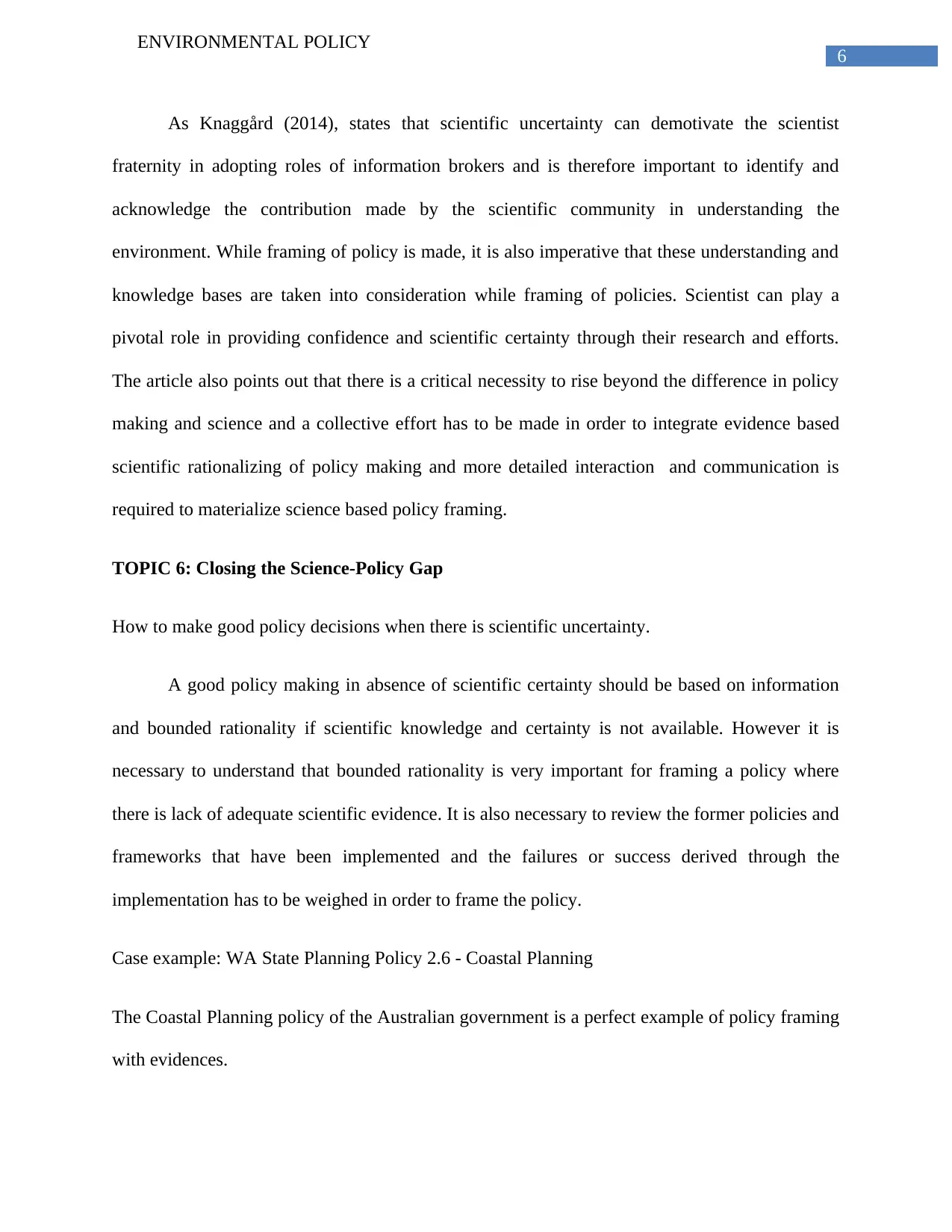
6
ENVIRONMENTAL POLICY
As Knaggård (2014), states that scientific uncertainty can demotivate the scientist
fraternity in adopting roles of information brokers and is therefore important to identify and
acknowledge the contribution made by the scientific community in understanding the
environment. While framing of policy is made, it is also imperative that these understanding and
knowledge bases are taken into consideration while framing of policies. Scientist can play a
pivotal role in providing confidence and scientific certainty through their research and efforts.
The article also points out that there is a critical necessity to rise beyond the difference in policy
making and science and a collective effort has to be made in order to integrate evidence based
scientific rationalizing of policy making and more detailed interaction and communication is
required to materialize science based policy framing.
TOPIC 6: Closing the Science-Policy Gap
How to make good policy decisions when there is scientific uncertainty.
A good policy making in absence of scientific certainty should be based on information
and bounded rationality if scientific knowledge and certainty is not available. However it is
necessary to understand that bounded rationality is very important for framing a policy where
there is lack of adequate scientific evidence. It is also necessary to review the former policies and
frameworks that have been implemented and the failures or success derived through the
implementation has to be weighed in order to frame the policy.
Case example: WA State Planning Policy 2.6 - Coastal Planning
The Coastal Planning policy of the Australian government is a perfect example of policy framing
with evidences.
ENVIRONMENTAL POLICY
As Knaggård (2014), states that scientific uncertainty can demotivate the scientist
fraternity in adopting roles of information brokers and is therefore important to identify and
acknowledge the contribution made by the scientific community in understanding the
environment. While framing of policy is made, it is also imperative that these understanding and
knowledge bases are taken into consideration while framing of policies. Scientist can play a
pivotal role in providing confidence and scientific certainty through their research and efforts.
The article also points out that there is a critical necessity to rise beyond the difference in policy
making and science and a collective effort has to be made in order to integrate evidence based
scientific rationalizing of policy making and more detailed interaction and communication is
required to materialize science based policy framing.
TOPIC 6: Closing the Science-Policy Gap
How to make good policy decisions when there is scientific uncertainty.
A good policy making in absence of scientific certainty should be based on information
and bounded rationality if scientific knowledge and certainty is not available. However it is
necessary to understand that bounded rationality is very important for framing a policy where
there is lack of adequate scientific evidence. It is also necessary to review the former policies and
frameworks that have been implemented and the failures or success derived through the
implementation has to be weighed in order to frame the policy.
Case example: WA State Planning Policy 2.6 - Coastal Planning
The Coastal Planning policy of the Australian government is a perfect example of policy framing
with evidences.
⊘ This is a preview!⊘
Do you want full access?
Subscribe today to unlock all pages.

Trusted by 1+ million students worldwide
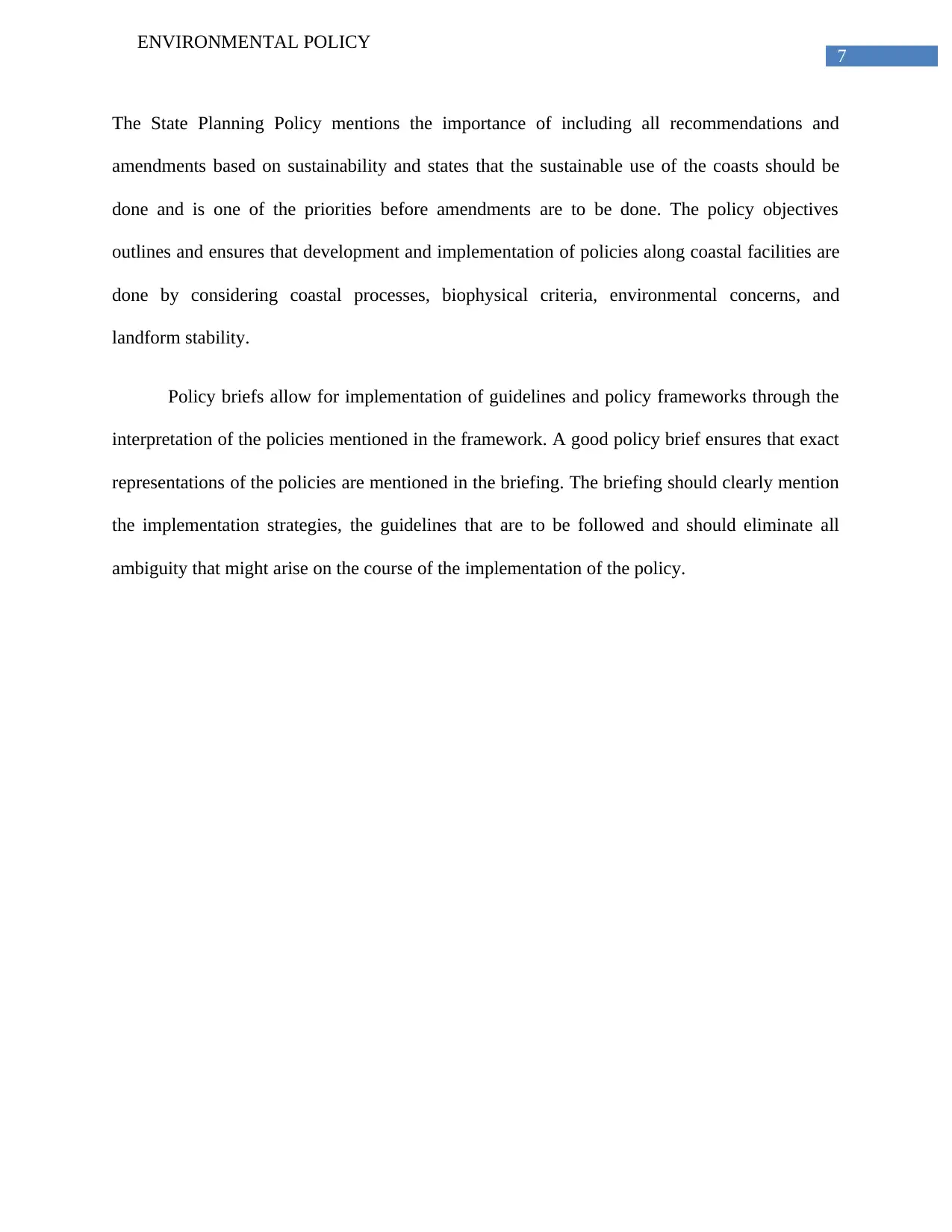
7
ENVIRONMENTAL POLICY
The State Planning Policy mentions the importance of including all recommendations and
amendments based on sustainability and states that the sustainable use of the coasts should be
done and is one of the priorities before amendments are to be done. The policy objectives
outlines and ensures that development and implementation of policies along coastal facilities are
done by considering coastal processes, biophysical criteria, environmental concerns, and
landform stability.
Policy briefs allow for implementation of guidelines and policy frameworks through the
interpretation of the policies mentioned in the framework. A good policy brief ensures that exact
representations of the policies are mentioned in the briefing. The briefing should clearly mention
the implementation strategies, the guidelines that are to be followed and should eliminate all
ambiguity that might arise on the course of the implementation of the policy.
ENVIRONMENTAL POLICY
The State Planning Policy mentions the importance of including all recommendations and
amendments based on sustainability and states that the sustainable use of the coasts should be
done and is one of the priorities before amendments are to be done. The policy objectives
outlines and ensures that development and implementation of policies along coastal facilities are
done by considering coastal processes, biophysical criteria, environmental concerns, and
landform stability.
Policy briefs allow for implementation of guidelines and policy frameworks through the
interpretation of the policies mentioned in the framework. A good policy brief ensures that exact
representations of the policies are mentioned in the briefing. The briefing should clearly mention
the implementation strategies, the guidelines that are to be followed and should eliminate all
ambiguity that might arise on the course of the implementation of the policy.
Paraphrase This Document
Need a fresh take? Get an instant paraphrase of this document with our AI Paraphraser
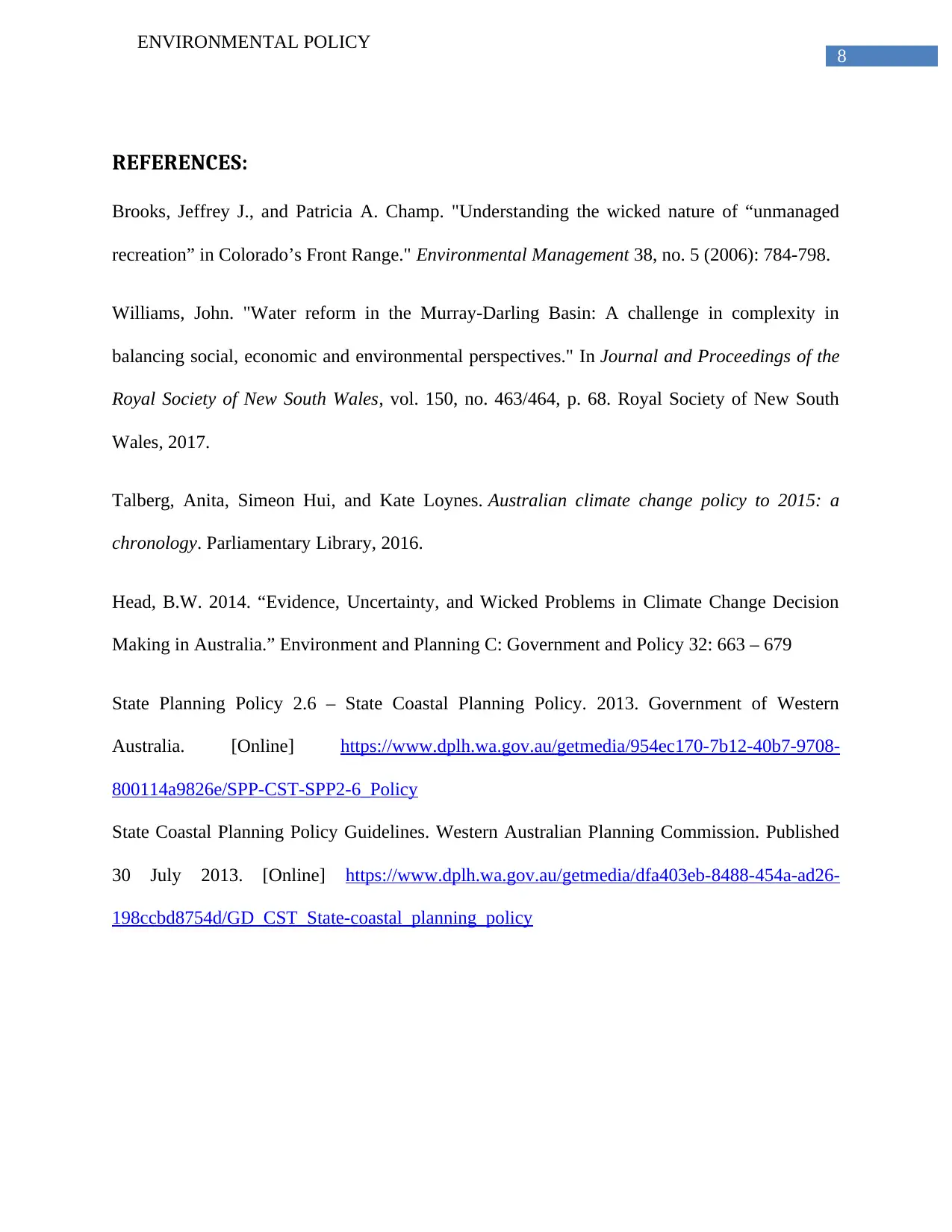
8
ENVIRONMENTAL POLICY
REFERENCES:
Brooks, Jeffrey J., and Patricia A. Champ. "Understanding the wicked nature of “unmanaged
recreation” in Colorado’s Front Range." Environmental Management 38, no. 5 (2006): 784-798.
Williams, John. "Water reform in the Murray-Darling Basin: A challenge in complexity in
balancing social, economic and environmental perspectives." In Journal and Proceedings of the
Royal Society of New South Wales, vol. 150, no. 463/464, p. 68. Royal Society of New South
Wales, 2017.
Talberg, Anita, Simeon Hui, and Kate Loynes. Australian climate change policy to 2015: a
chronology. Parliamentary Library, 2016.
Head, B.W. 2014. “Evidence, Uncertainty, and Wicked Problems in Climate Change Decision
Making in Australia.” Environment and Planning C: Government and Policy 32: 663 – 679
State Planning Policy 2.6 – State Coastal Planning Policy. 2013. Government of Western
Australia. [Online] https://www.dplh.wa.gov.au/getmedia/954ec170-7b12-40b7-9708-
800114a9826e/SPP-CST-SPP2-6_Policy
State Coastal Planning Policy Guidelines. Western Australian Planning Commission. Published
30 July 2013. [Online] https://www.dplh.wa.gov.au/getmedia/dfa403eb-8488-454a-ad26-
198ccbd8754d/GD_CST_State-coastal_planning_policy
ENVIRONMENTAL POLICY
REFERENCES:
Brooks, Jeffrey J., and Patricia A. Champ. "Understanding the wicked nature of “unmanaged
recreation” in Colorado’s Front Range." Environmental Management 38, no. 5 (2006): 784-798.
Williams, John. "Water reform in the Murray-Darling Basin: A challenge in complexity in
balancing social, economic and environmental perspectives." In Journal and Proceedings of the
Royal Society of New South Wales, vol. 150, no. 463/464, p. 68. Royal Society of New South
Wales, 2017.
Talberg, Anita, Simeon Hui, and Kate Loynes. Australian climate change policy to 2015: a
chronology. Parliamentary Library, 2016.
Head, B.W. 2014. “Evidence, Uncertainty, and Wicked Problems in Climate Change Decision
Making in Australia.” Environment and Planning C: Government and Policy 32: 663 – 679
State Planning Policy 2.6 – State Coastal Planning Policy. 2013. Government of Western
Australia. [Online] https://www.dplh.wa.gov.au/getmedia/954ec170-7b12-40b7-9708-
800114a9826e/SPP-CST-SPP2-6_Policy
State Coastal Planning Policy Guidelines. Western Australian Planning Commission. Published
30 July 2013. [Online] https://www.dplh.wa.gov.au/getmedia/dfa403eb-8488-454a-ad26-
198ccbd8754d/GD_CST_State-coastal_planning_policy

9
ENVIRONMENTAL POLICY
ENVIRONMENTAL POLICY
⊘ This is a preview!⊘
Do you want full access?
Subscribe today to unlock all pages.

Trusted by 1+ million students worldwide
1 out of 9
Your All-in-One AI-Powered Toolkit for Academic Success.
+13062052269
info@desklib.com
Available 24*7 on WhatsApp / Email
![[object Object]](/_next/static/media/star-bottom.7253800d.svg)
Unlock your academic potential
Copyright © 2020–2025 A2Z Services. All Rights Reserved. Developed and managed by ZUCOL.
